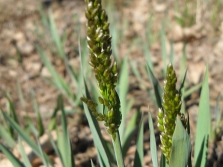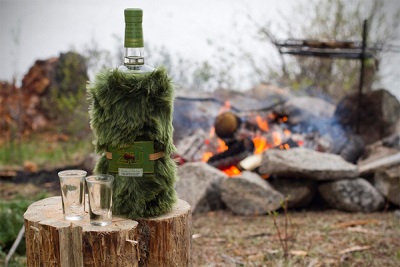Zubrovka

Zubrovka (also called glacier) refers to perennial plants from the Cereal family. The grass has a pleasant fragrant smell, therefore, translated from English, its name sounds like "sweet grass". The plant got its name in Russia due to the fact that it is a favorite delicacy of bison. The bison is also called turovka among the people, since tours also like to feast on this grass.

Appearance
The rhizome of bison is creeping and long. The stem is smooth and straight, on its body there are thickenings in the form of knots. In height, it can reach 0.3-0.7 m. The leaves are flat, elongated and pointed towards their upper part. Basal leaves are longer than those closer to the top. The front side of the leaf is green, the back has a light grayish tint.
The bison flowers have a brown-golden color and gather in a large number of oblong spikes, which form sprawling panicles. The fruits consist of dark brown grains and reach the peak of ripening by August. The bison has very small seeds, which is very inconvenient when planting them in the soil.

Kinds
The bison has about 30 related species. Eight of them are found in Russia and neighboring countries.
The most commonly seen types are:
- fragrant;
- South;
- creeping.
The second type is actively used in cooking, but the first one has a stronger aroma, so it is used more often, including in traditional medicine.



Where does it grow?
Zubrovka can most often be found on the edges of forests, in thickets, it also grows near roads, in pine or spruce forests, along rivers and in mountains, at altitudes up to 3 km.
The grass has received the greatest distribution in temperate latitudes in European and Asian territories, on hills in tropical zones, in North America. Zubrovka endures cold, therefore it grows in large numbers in the European part of Russia, in the west of Siberia, the Far Eastern territories, in the Caucasus Mountains. Found as a weed. It can grow in almost any soil, but sandy soil is preferable for bison.

Peculiarities
Zubrovka looks rather inconspicuous, but has a very pleasant fresh aroma, so the grass is even used as a flavoring for tobacco. Often the plant serves as food for livestock, as it helps to increase milk yield, but it is impossible for animals to consume it in large quantities.
The branched root system of bison helps in strengthening embankments and steep slopes.

Characteristics
Zubrovka has the following characteristics:
- is a medicinal plant;
- has a bitter and tart taste;
- has a fragrant aroma;
- contains a large amount of vitamins and minerals;
- The flowering of the plant occurs at the end of spring-beginning of summer.

Chemical composition
Zubrovka is rich in its chemical composition. It includes:
- coumarin;
- vitamins (B1, B2, B5, B6, B9, B12, C, H, PP);
- potassium;
- calcium;
- magnesium;
- zinc;
- copper;
- selenium;
- manganese;
- phosphorus;
- sodium;
- iron;
- vitamin C;
- ferulic acid;
- alkaloids;
- bitterness.
The fresh and fragrant aroma of the plant is the merit of coumarin. Thanks to this substance, the plant can be used to stop the bleeding.
Ascorbic acid, being a natural antioxidant, helps to strengthen the tissues and bones of the body and improve metabolic processes.
Ferulic acid is also an antioxidant that has beneficial effects on the skin, slowing down aging and protecting the skin from UV radiation.
The bitterness contained in bison improves appetite, and alkaloids help keep muscles in good shape.
For more information about bison, you can find out by watching the video from the program "1000 and one spice of Scheherazade."
Beneficial features
The list of useful properties of bison is quite long:
- restores skin and hair pigmentation;
- is an excellent hemostatic agent;
- exhibits anti-cancer activity;
- strengthens muscles and vascular walls;
- improves metabolism;
- has an antibacterial effect;
- increases appetite;
- normalizes the functioning of the nervous system;
- stabilizes the work of the heart;
- exhibits antiseptic properties;
- increases lactation.
The plant is widely used in folk medicine due to its high content of useful minerals and vitamins. It is actively used in viral diseases, increasing sweating. Zubrovka not only increases appetite, but also helps in the treatment of gastrointestinal diseases.

Harm
Despite the fact that the herb does not cause much harm to the body, there are some side effects:
- headache;
- residues of plant substances in breast milk when using bison to enhance lactation;
- deterioration in the health of livestock.
Headaches occur due to an overdose of coumarin, there is even the possibility of migraines.
If you use bison decoctions on your own to enhance lactation, then there is a risk of harming the health of the child, since particles of the active substances of the herb can remain in breast milk.
A large amount of bison in livestock feed is akin to poison for pets.
When using the plant in aromatherapy, you should not mix it with other coumarin-containing herbs, as well as cinnamon oil.
Official medicine does not use bison for the manufacture of medicines, therefore it is not always safe to prescribe self-treatment with decoctions or infusions of the plant.
Contraindications
Do not use teething:
- pregnant women;
- in the presence of neuroses or other similar diseases of the nervous system;
- with insomnia;
- with personal intolerance to the plant;
- in the presence of acute forms of diseases of the gastrointestinal tract.

Oil
The essential oil of the plant is a frequent component in the production of perfumes and cosmetics, as its smell is similar to the fresh scent of cut hay.

Application
In cooking
In cooking, bison has found quite a wide application:
- in the production of alcoholic beverages;
- in the preparation of confectionery;
- in marinade;
- in some spices.
Surely everyone knows the famous Zubrovka tincture, the history of which dates back to the Middle Ages. Thanks to the addition of a plant of the same name to it, the tincture acquires a bright herbal aroma. Zubrovka also acted as a component of honey liquor as part of other spices. The liqueur recipe was known in Poland more than five centuries ago.
In the manufacture of confectionery, bison is often used to obtain essences that enhance the taste and aroma of products.
The herb is very popular as a spice for fish dishes. Zubrovka is added to some canned fish, as well as to a herring marinade.
Zubrovka is rarely used as a separate spice, as it has a rather specific taste. Its addition usually depends on personal preference. One French chef used bison as a spice in sauces. He was able to take second place in a culinary competition by stewing a pork shoulder and serving it in bison sauce.

Tincture
You can make homemade tincture from bison. For this you need:
- take 500 ml of vodka and a couple of plant stems;
- infuse vodka with the addition of bison stalks to it for ten days.
The result is an infusion of light green color with a slightly tart flavor and herbal aroma.
Alcoholic cocktail
Tasty alcoholic cocktails are also prepared from bison. For example, the Polish martini. To prepare it, you will need:
- 50 ml of Zubrovka tincture;
- 25 ml of apple vodka;
- 25 ml lime juice;
- 90 ml of apple juice;
- a couple of drops of vanilla essence;
- five grapes;
- apple slices for garnish.
All ingredients except apples are mixed and shaken, then poured into a glass filled with ice, which is then decorated with apple slices.



In medicine
In folk medicine, bison occupies an honorable place. It can be used to treat:
- diseases of the gastrointestinal tract, including colitis, gastritis, ulcers;
- viral diseases;
- fever
- anorexia nervosa;
- tuberculosis;
- cough.
For medicinal purposes, only the stem and leaves of bison are used, excluding basal ones. After collecting the grass, the inflorescences are cut off, and the stems with leaves are dried in the air.
Lotions from bison tincture help to clot blood and promote faster healing of wounds, and also help in the treatment of fungus.Decoctions of herbs stimulate appetite, strengthen the stomach and intestines.

When losing weight
Quite often, bison is used as a specific means for weight loss. If you drink tea with the addition of herbs, then sweating begins to increase, respectively, the weight decreases slightly. At the same time, the metabolic rate does not increase, and fat is not burned. This method of losing weight is not approved by doctors, so you should not take it seriously.

At home
Zubrovka is applied:
- as a fragrance or fragrance;
- in agriculture;
- to strengthen steep slopes.
If bison is added to hay intended for livestock feed, then the animals' appetite increases and milk yield improves. However, they do not really like the plant, as its smell is too harsh for them.

cultivation
Roots and plants are long and creeping. There are many nodules on the rhizome, a new bush grows from them, from which another one is formed, etc. The roots are tightly intertwined, so bison can be an undesirable neighbor for other plants. It is better to protect the landing site with something.
Grass can be sown using seeds or cuttings. The seeds of the plant are extremely small and do not germinate well, so it is better to take seedlings or cuttings. In order for bison to grow quickly, you need to water it often and periodically feed it with fertilizers.
If bison are propagated by seeds, then they need to be planted to a shallow depth of up to 1.5 cm. Ten days later, the first shoots will appear.
Plant care is practically not required, as its powerful root system successfully displaces other weeds. Diseases and pests of the plant are also not terrible. The lack of watering and fertilizers negatively affects bison.

Interesting Facts
Remarkably enough, bison is considered a sacred plant. And there are still beliefs that its smoke scares away evil spirits. The Indians wove grass into their hair, and for a long time, believers set fire to the leaves during religious rites or scattered them in front of the entrance to the temple or church.
Indian girls used bison, weaving baskets and mats from it, and also stuffing pillows with it. Insects were repelled by the smell of the plant, but at the same time it was pleasant for humans.
In Europe, sometimes to this day churches are decorated on holidays with bunches of bison, from which a pleasant sweetish aroma goes up.











I like to add bison to the fish, it gives an unusual, but pleasant taste and aroma.
I grow this herb in my garden. I make my own bison tincture - very tasty!